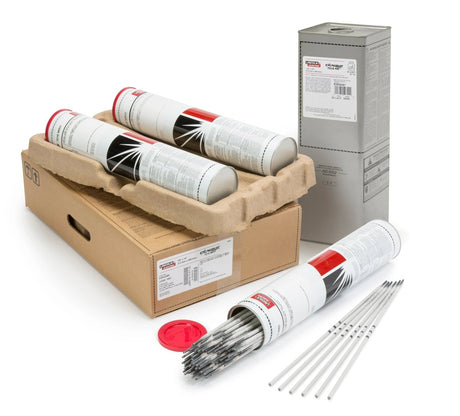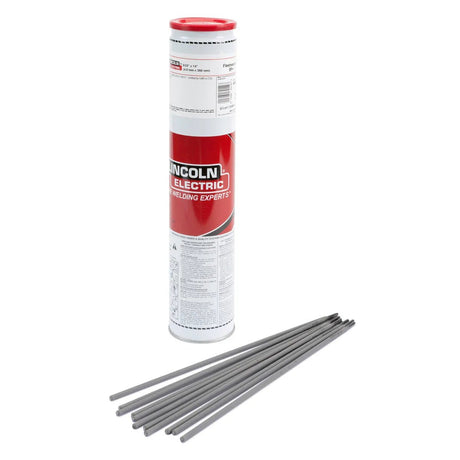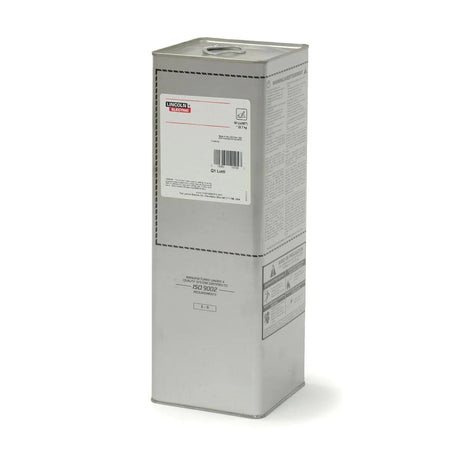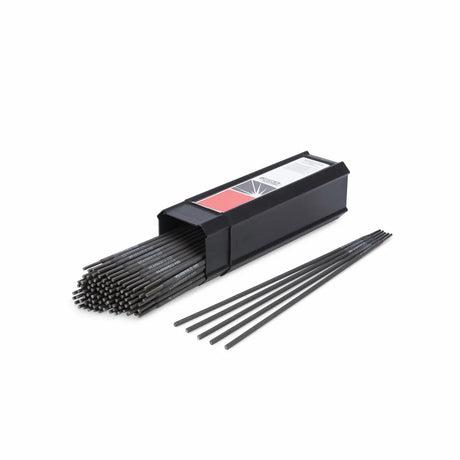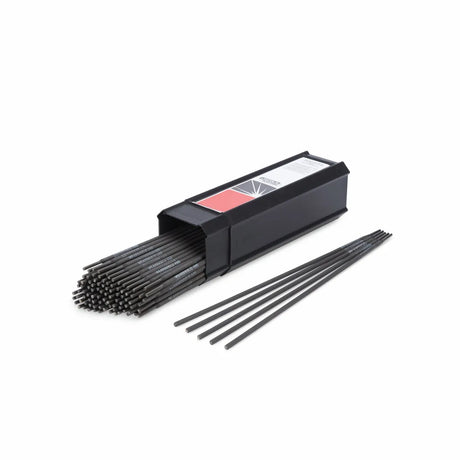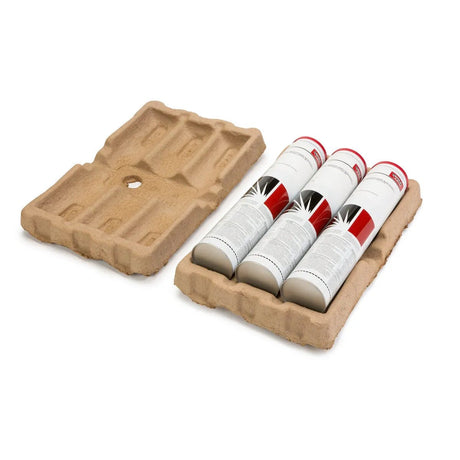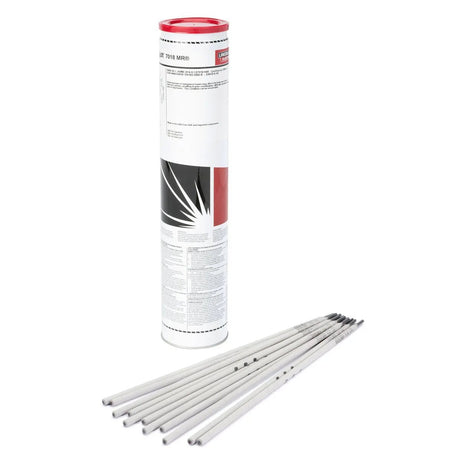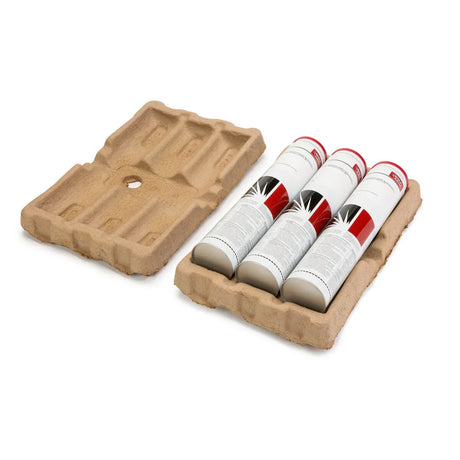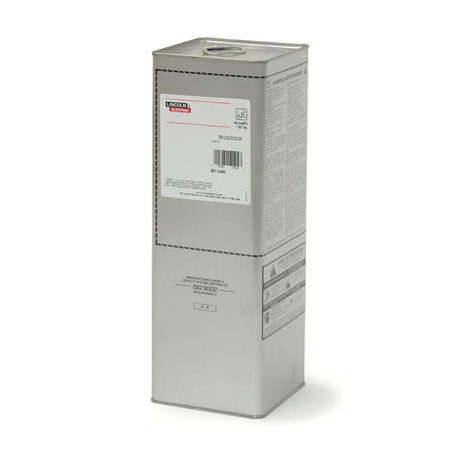Shop welding rods for stainless steel, cast iron, and aluminum. Find electrodes and filler metals for stick, TIG, and MIG welding with strong, durable results.
Lincoln Electric Excalibur 7018 MR Stick Welding Rod
From $67.08Unit price /UnavailableLincoln ED032565 Fleetweld 5P Stick SMAW Welding Rod 1/8X14in 3 10 lb Easy Open Cans
$216.60$232.50Unit price /UnavailableLincoln ED032588 Excalibur 7018 MR Stick SMAW Welding Rod 3/32 14in 3 10 lb Easy Open Cans
$178.20$198.00Unit price /UnavailableLincoln Electric Fleetweld 5P Stick Welding Rod 1/8 X 14 50lb Easy Open Can ED010278
$284.49$339.50Unit price /UnavailableLincoln ED010285 Fleetweld 5P Stick SMAW Welding Rod 5/32X14in 50 lb Easy Open Can
$308.68$334.50Unit price /UnavailableLincoln ED032877 Excalibur 7018 A1 MR Stick SMAW Welding Rod 5/32X14in 50 lb Easy Open Can
$345.93$406.50Unit price /UnavailableLincoln ED022011 Wearshield 60 Stick SMAW Welding Rod 5/32 14in 10 lb Plastic Tube
$139.53$152.60Unit price /UnavailableLincoln ED034456 Pipeliner Arc 80 Stick SMAW Welding Rod 5/32 14in 50 lb Easy Open Can
$320.25$376.00Unit price /UnavailableLincoln ED032564 Fleetweld 5P Stick SMAW Welding Rod 3/32X12in 3 10 lb Easy Open Cans
$216.20$249.60Unit price /UnavailableLincoln ED028153 Fleetweld 35 Stick SMAW Welding Rod 1/8X14in 50 lb Easy Open Can
$274.25$324.00Unit price /UnavailableLincoln ED021998 Wearshield Abr Stick SMAW Welding Rod 5/32 14in 10 lb Plastic Tube
$78.74$113.80Unit price /UnavailableLincoln ED021976 Wearshield Mangjet Stick SMAW Welding Rod 5/32 14in 10 lb Plastic Tubes
$113.35$114.80Unit price /UnavailableLincoln ED037426 Excalibur 7018 XMR Stick SMAW Welding Rod 1/8X14in 3 10 lb Easy Open Can
$193.76$219.00Unit price /UnavailableLincoln ED032589 Excalibur 7018 MR Stick SMAW Welding Rod 1/8 14in 3 10 lb Easy Open Cans
$178.20$198.00Unit price /UnavailableLincoln ED028282 Excalibur 7018 MR Stick SMAW Welding Rod 5/32 14in 50 lb Easy Open Can
$250.20$278.00Unit price /UnavailableLincoln ED034457 Pipeliner Arc 80 Stick SMAW Welding Rod 3/16 14in 50 lb Easy Open Can
$322.25$379.50Unit price /UnavailableLincoln ED032876 Excalibur 7018 A1 MR Stick SMAW Welding Rod 1/8X14in 50 lb Easy Open Can
$340.25$412.00Unit price /UnavailableLincoln ED028280 Excalibur 7018 MR Stick SMAW Welding Rod 3/32 14in 50 lb Easy Open Can
$259.20$288.00Unit price /UnavailableLincoln ED037425 Excalibur 7018 XMR Stick SMAW Welding Rod 3/32X14in 3 10 lb Easy Open Can
$207.70$219.00Unit price /UnavailableLincoln ED012849 Shield Arc 70 Stick SMAW Welding Rod 5/32X14in 50 lb Easy Open Can
$316.50Unit price /Unavailable
A Comprehensive Guide to Welding Rods and Techniques: Stainless Steel, Cast Iron, and Aluminum
Introduction to Welding Rods and Techniques
Overview of Welding Materials
When using welding rods, understanding the needs of the materials involved proves vital for successful outcomes. Welding is a critical operation in fabrication, construction, and repair, meeting the industry’s need for durability and versatility. The welding process requires manual dexterity and careful control of factors such as electrode choice, joint type, arc length, and welding machine settings. The choice of welding rod—also known as an electrode—can dramatically impact the strength, appearance, and durability of the finished weld, especially when using stainless steel, cast iron, or aluminum rods. It is crucial to consider both stick and other methods such as TIG and MIG welding to achieve the best results. For metals like stainless steel, cast iron, and aluminum, using specific stick and other electrodes ensures effective fusion and minimizes the risk of structural weaknesses and cracks.
Importance of Choosing the Right Rod
Each metal, be it stainless steel, cast iron, or aluminum, has unique properties that affect how it responds to heat, electrical current, and filler material. For instance, cast iron welds need careful joint preparation to prevent defects. Selecting the appropriate welding electrode aligns its content closely with the base material, leading to durable bonds and preventing cracks, porosity, and corrosion. Using the right electrodes is essential for ensuring that welds meet the mechanical and visual standards required for the intended application, especially in metals like cast iron. Given the brittle nature of cast iron, it often requires special attention to heat control and electrode choice.
Types of Welding Electrodes
Stainless Steel Welding Rods
Stainless steel welding rods provide corrosion resistance and create a high-strength bead. The most widely used types are 308, 309, and 316 stainless electrodes, each tailored for specific alloy grades and environments. These rods offer smooth arc characteristics and are favored in industries like food processing, where they provide excellent corrosion resistance. Including these electrodes reliably withstands harsh conditions, making them key to construction and manufacturing.
Cast Iron Welding Rods
Cast iron presents unique welding challenges due to its brittle nature and high carbon and iron content, often requiring specialized choices. Specialized cast iron welding rods, such as nickel rods, reduce cracking and ensure a ductile weld. They help reduce the risk of cracking and ensure a ductile, manageable weld. These rods work well for repairing engine blocks and other heavy-duty cast pieces.
Aluminum Welding Rods
Aluminum requires dedicated rods due to its distinct melting point and oxide layer. The dedicated nature of these rods aids in ensuring that each weld joint achieves maximum integrity. Despite being less common than MIG or TIG, aluminum stick welding rods allow welders to tackle aluminum effectively. Aluminum rods typically contain alloying elements like magnesium or silicon for optimal flow, strength, and crack resistance. This composition helps to prevent burn-through and supports the high-quality production of aluminum joints.
Welding Techniques for Different Metals
Stick Welding Techniques
Stick welding, or Shielded Metal Arc Welding (SMAW), is especially valued for its versatility, portability, and effectiveness across various base metals, including stainless steel and cast iron. Benefiting from versatile filler metals, stick welding produces quality welds even in challenging conditions. Cast iron welding requires careful heat management whereas stick welding aluminum demands a rapid technique to avoid oxidation. Stick SMAW welders must also remain vigilant with their heat and amperage settings.
TIG and MIG Welding Comparisons
These alternatives use different core elements which can be matched to specific aluminum welding requirements. While stick welding is versatile, TIG (Tungsten Inert Gas) and MIG (Metal Inert Gas) welding both offer advantages, particularly for stainless steel and aluminum. TIG welding provides precise, clean welds with excellent arc control, making it ideal for thin materials. MIG welding offers quick deposition rates, perfect for longer welds under controlled conditions and aided by the proper power settings. Stick welding remains preferred for fieldwork where portable and straightforward equipment is valuable. Stick welders often find that proper arc control enhances weld quality and efficiency.
Best Practices for Each Material
- Stainless Steel: Use the correct electrode type, pre-clean surfaces, and control interpass temperatures to avoid warping or carbide precipitation.
- The right Stainless steel rod should form solid, corrosion-resistant weld beads for the intended application.
- Cast Iron: Preheat larger sections where possible, employ nickel-based electrodes, and allow gradual cooling.
- With cast iron welding, the core must be carefully monitored to maintain a strong and ductile weld.
- Aluminum: Thoroughly clean oxide layers pre-weld, use fast travel speeds, and consider preheating for thicker pieces when stick welding aluminum.
Proper flux use is critical in aluminum stick welding to improve weld quality.
Proper flux application is critical in stick welding aluminum to prevent oxidation and improve weld stability.
Industry-Specific Uses
- Stick welder operators look for specific rod coatings to improve adhesion and reduce defects.
- Welding cast iron rods crucially depend on selecting suitable protective coatings to shield the weld from contamination and improve outcomes.
- Stainless steel rods are used widely in industries like food processing, providing great corrosion resistance and quality.
- Cast iron rods are crucial for equipment repair in automotive, machinery maintenance, and industrial foundries.
- In these scenarios, casting defects require correction through meticulous stick welds.
- In such challenging environments, welders must manage their arc and the electrode’s position carefully to ensure good results.
- Aluminum rods are perfect for marine construction and automotive applications due to their lightweight nature.
- This allows aluminum components to benefit from their lightweight form without losing strength.
Challenges in Welding Different Materials
Each metal poses challenges: - Stainless steel: Risk of carbide precipitation if overheated. - Stick welding aluminum: Requires precise temperature control to minimize distortion and enhance bead quality. A proper arc provides stability that fosters good bead integrity. Proper joint preparation and specialized stick electrodes are vital for iron alloys. Joint preparation and electrode choice play significant roles in overcoming welding obstacles in these materials. Craftsmen must look at the intricacies of each material's reaction to welding heat to minimize risks.
Skillful technique, proper rod selection, and understanding of metallurgical principles are vital for overcoming these hurdles. Stick electrode techniques must evolve to meet new metallurgical challenges.
Advancing recently in areas of welding rods also promise to create improved outcomes.
Cutting-edge machine technologies provide welders direct control over arc stability, improving penetration.
Developments in welding machine technologies now offer more direct control over arc stability, leading to improved penetration and better results. Innovations in alloy compositions aim for improved crack resistance in cast and stainless applications. Emerging alloy composite rods offer enhanced corrosion resistance and compatibility with innovative materials, boosting the potential for new manufacturing.
Educational Resources for Welders
Continued education remains fundamental for welders at all levels. It allows welders to learn more advanced skills, including the use of new types of electrodes. Welders can quickly learn about advanced arc techniques through educational programs offered by welding associations, ensuring adherence to best practices. Staying current with the latest developments ensures safe, efficient, and high-quality welds across stainless steel, cast iron, aluminum, and beyond.
A Comprehensive Guide to Welding Rods and Techniques: Stainless Steel, Cast Iron, and Aluminum
Introduction to Welding Rods and Techniques
Overview of Welding Materials
When using welding rods, understanding the needs of the materials involved proves vital for successful outcomes. Welding is a critical operation in fabrication, construction, and repair, meeting the industry’s need for durability and versatility. The welding process requires manual dexterity and careful control of factors such as electrode choice, joint type, arc length, and welding machine settings. The choice of welding rod—also known as an electrode—can dramatically impact the strength, appearance, and durability of the finished weld, especially when using stainless steel, cast iron, or aluminum rods. It is crucial to consider both stick and other methods such as TIG and MIG welding to achieve the best results. For metals like stainless steel, cast iron, and aluminum, using specific stick and other electrodes ensures effective fusion and minimizes the risk of structural weaknesses and cracks.
Importance of Choosing the Right Rod
Each metal, be it stainless steel, cast iron, or aluminum, has unique properties that affect how it responds to heat, electrical current, and filler material. For instance, cast iron welds need careful joint preparation to prevent defects. Selecting the appropriate welding electrode aligns its content closely with the base material, leading to durable bonds and preventing cracks, porosity, and corrosion. Using the right electrodes is essential for ensuring that welds meet the mechanical and visual standards required for the intended application, especially in metals like cast iron. Given the brittle nature of cast iron, it often requires special attention to heat control and electrode choice.
Types of Welding Electrodes
Stainless Steel Welding Rods
Stainless steel welding rods provide corrosion resistance and create a high-strength bead. The most widely used types are 308, 309, and 316 stainless electrodes, each tailored for specific alloy grades and environments. These rods offer smooth arc characteristics and are favored in industries like food processing, where they provide excellent corrosion resistance. Including these electrodes reliably withstands harsh conditions, making them key to construction and manufacturing.
Cast Iron Welding Rods
Cast iron presents unique welding challenges due to its brittle nature and high carbon and iron content, often requiring specialized choices. Specialized cast iron welding rods, such as nickel rods, reduce cracking and ensure a ductile weld. They help reduce the risk of cracking and ensure a ductile, manageable weld. These rods work well for repairing engine blocks and other heavy-duty cast pieces.
Aluminum Welding Rods
Aluminum requires dedicated rods due to its distinct melting point and oxide layer. The dedicated nature of these rods aids in ensuring that each weld joint achieves maximum integrity. Despite being less common than MIG or TIG, aluminum stick welding rods allow welders to tackle aluminum effectively. Aluminum rods typically contain alloying elements like magnesium or silicon for optimal flow, strength, and crack resistance. This composition helps to prevent burn-through and supports the high-quality production of aluminum joints.
Welding Techniques for Different Metals
Stick Welding Techniques
Stick welding, or Shielded Metal Arc Welding (SMAW), is especially valued for its versatility, portability, and effectiveness across various base metals, including stainless steel and cast iron. Benefiting from versatile filler metals, stick welding produces quality welds even in challenging conditions. Cast iron welding requires careful heat management whereas stick welding aluminum demands a rapid technique to avoid oxidation. Stick SMAW welders must also remain vigilant with their heat and amperage settings.
TIG and MIG Welding Comparisons
These alternatives use different core elements which can be matched to specific aluminum welding requirements. While stick welding is versatile, TIG (Tungsten Inert Gas) and MIG (Metal Inert Gas) welding both offer advantages, particularly for stainless steel and aluminum. TIG welding provides precise, clean welds with excellent arc control, making it ideal for thin materials. MIG welding offers quick deposition rates, perfect for longer welds under controlled conditions and aided by the proper power settings. Stick welding remains preferred for fieldwork where portable and straightforward equipment is valuable. Stick welders often find that proper arc control enhances weld quality and efficiency.
Best Practices for Each Material
- Stainless Steel: Use the correct electrode type, pre-clean surfaces, and control interpass temperatures to avoid warping or carbide precipitation.
- The right Stainless steel rod should form solid, corrosion-resistant weld beads for the intended application.
- Cast Iron: Preheat larger sections where possible, employ nickel-based electrodes, and allow gradual cooling.
- With cast iron welding, the core must be carefully monitored to maintain a strong and ductile weld.
- Aluminum: Thoroughly clean oxide layers pre-weld, use fast travel speeds, and consider preheating for thicker pieces when stick welding aluminum.
Proper flux use is critical in aluminum stick welding to improve weld quality.
Proper flux application is critical in stick welding aluminum to prevent oxidation and improve weld stability.
Industry-Specific Uses
- Stick welder operators look for specific rod coatings to improve adhesion and reduce defects.
- Welding cast iron rods crucially depend on selecting suitable protective coatings to shield the weld from contamination and improve outcomes.
- Stainless steel rods are used widely in industries like food processing, providing great corrosion resistance and quality.
- Cast iron rods are crucial for equipment repair in automotive, machinery maintenance, and industrial foundries.
- In these scenarios, casting defects require correction through meticulous stick welds.
- In such challenging environments, welders must manage their arc and the electrode’s position carefully to ensure good results.
- Aluminum rods are perfect for marine construction and automotive applications due to their lightweight nature.
- This allows aluminum components to benefit from their lightweight form without losing strength.
Challenges in Welding Different Materials
Each metal poses challenges: - Stainless steel: Risk of carbide precipitation if overheated. - Stick welding aluminum: Requires precise temperature control to minimize distortion and enhance bead quality. A proper arc provides stability that fosters good bead integrity. Proper joint preparation and specialized stick electrodes are vital for iron alloys. Joint preparation and electrode choice play significant roles in overcoming welding obstacles in these materials. Craftsmen must look at the intricacies of each material's reaction to welding heat to minimize risks.
Skillful technique, proper rod selection, and understanding of metallurgical principles are vital for overcoming these hurdles. Stick electrode techniques must evolve to meet new metallurgical challenges.
Advancing recently in areas of welding rods also promise to create improved outcomes.
Cutting-edge machine technologies provide welders direct control over arc stability, improving penetration.
Developments in welding machine technologies now offer more direct control over arc stability, leading to improved penetration and better results. Innovations in alloy compositions aim for improved crack resistance in cast and stainless applications. Emerging alloy composite rods offer enhanced corrosion resistance and compatibility with innovative materials, boosting the potential for new manufacturing.
Educational Resources for Welders
Continued education remains fundamental for welders at all levels. It allows welders to learn more advanced skills, including the use of new types of electrodes. Welders can quickly learn about advanced arc techniques through educational programs offered by welding associations, ensuring adherence to best practices. Staying current with the latest developments ensures safe, efficient, and high-quality welds across stainless steel, cast iron, aluminum, and beyond.

